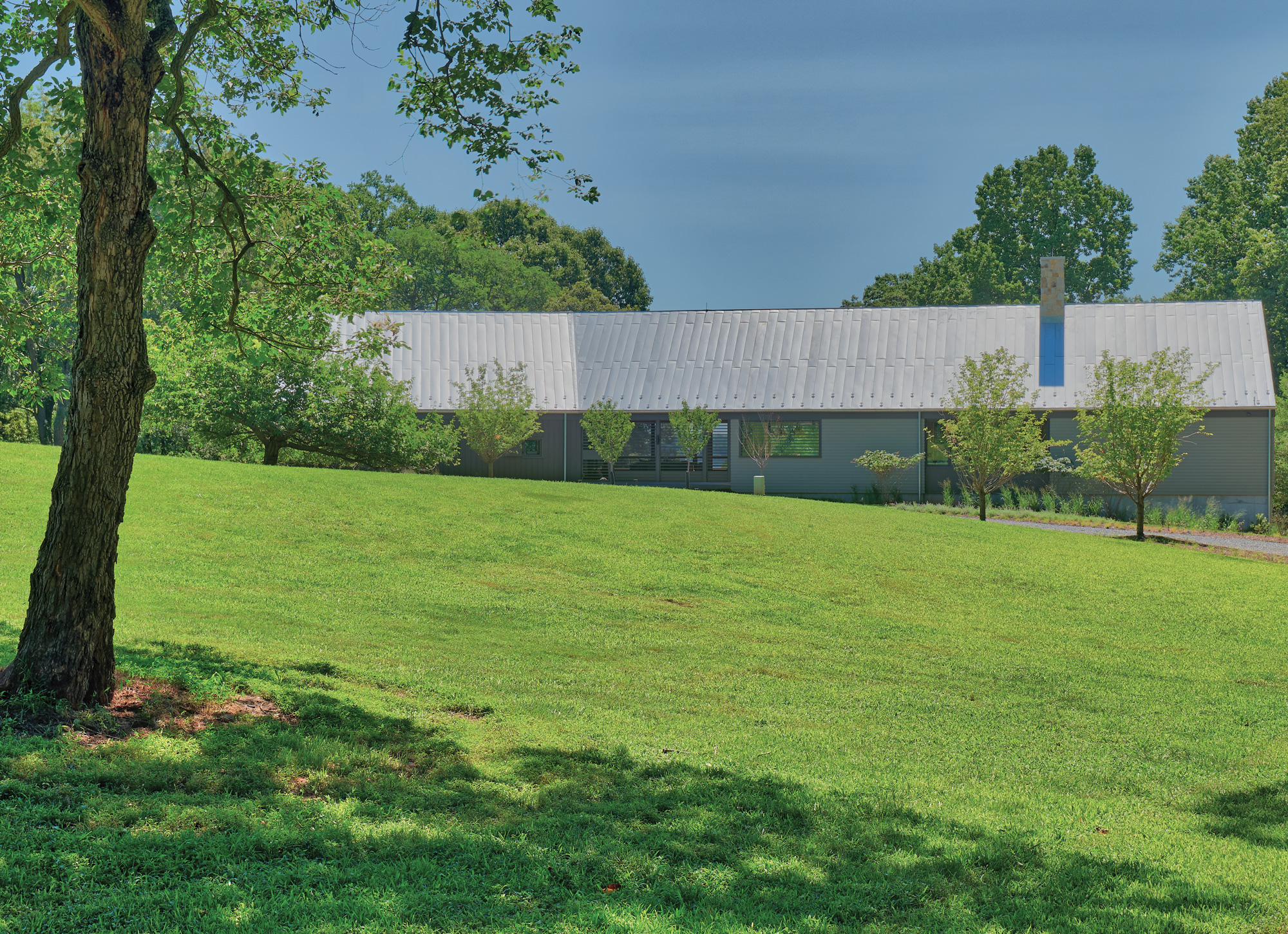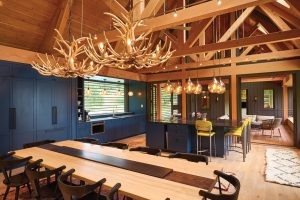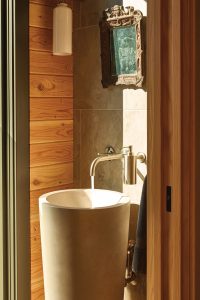- © 2025 Annapolis Home Magazine
- All Rights Reserved

There is a simple beauty to a country farm, a calmness to its weathered sheds, coops and barns. Architect Olvia Demetriou FAIA employed these iconic quiet forms when designing a get-away for clients who sought the solace of solitude, a place to exchange cell phones and flat screens for fox, deer and eagles.
Initially, Chris Niemczewski and Elise Hoffmann wanted a romantic one-bedroom weekend home overlooking their rural property on the Chesapeake Bay. However, their vision expanded and they ended up wanting a home large enough for their four grown children and friends to visit. One of the challenges was to design a large space with the low maintenance, low profile, and intimacy of a small one, explains Demetriou of the Washington D.C.-based HapstakDemetriou+.
Drawing on local materials and vernacular idioms, Demetriou designed one long barn-like structure with a guest house and master suite on each end. These two separate entities function independently of each other but are joined in the middle by a long porch. The exterior and interior are composed of many natural materials. A delicate range of intervening grays, blues, and browns allow this home to defer to and in this way illuminate the surrounding forest and marshlands or, in Demetriou’s words “set the stage for nature rather than the other way around.”
“Instead of using conventional ornamentation strategies including finishes, trim, crown moldings, etc., we drew on the appeal of natural woods and materials, relying on a repeating rhythm of trusses marching through space, to evoke the construction of a boat, or a barn,” recalls Demetriou.
She notes that much of the design was inspired by the beauty of the trusses supporting the pitched roof. Thomas D. Albright (T.D.), director of business development for Winchester Construction Company knows those trusses well. He believes they are one of the home’s most stunning features as well as challenging to work around. What you don’t see may be just as impressive as what you do see. They mask a complex system composed of HVAC, electrical wiring, plumbing and foam insulation, which are usually hidden conveniently in an attic.
 What also stood out on this job, he says, was the reliance on natural materials throughout the house, which create a more durable home that is easier to maintain. In this case, what you see becomes very important. “It is mainly composed of wood, stone, glass. There is a very limited amount of drywall, and limited painted surfaces.” “Everything is flushed out so there is not room for error. This pushed our craftsmen to do the best that they can, which is what we like to do. There are minimal overhangs and tight tolerances,” he says.
What also stood out on this job, he says, was the reliance on natural materials throughout the house, which create a more durable home that is easier to maintain. In this case, what you see becomes very important. “It is mainly composed of wood, stone, glass. There is a very limited amount of drywall, and limited painted surfaces.” “Everything is flushed out so there is not room for error. This pushed our craftsmen to do the best that they can, which is what we like to do. There are minimal overhangs and tight tolerances,” he says.
T.D. calls attention to built-in benches lining the porch that connects the two separate living quarters and, on its own, is a special interstitial space encouraging conversation, meditation, even wonder. “Deer fox eagles are everywhere. There are built-in heaters so you can truly enjoy the home. It’s a place where you can open up all the doors…it allows you to have a nice fluid space.”
 Fluidity was important to Demetriou and her clients. A mobile fluidity is fostered by the floor plan as well as a personal fluidity—the spaces are receptive to shifting moods. “It was important to find a way to balance privacy with hospitality—to create spaces where people can interact when they wish to, yet also be able to enjoy the intimacy that a private space affords,” says Demetriou.
Fluidity was important to Demetriou and her clients. A mobile fluidity is fostered by the floor plan as well as a personal fluidity—the spaces are receptive to shifting moods. “It was important to find a way to balance privacy with hospitality—to create spaces where people can interact when they wish to, yet also be able to enjoy the intimacy that a private space affords,” says Demetriou.
One of the best things about this house is its ability to embrace the private and social sides of one’s self, the extrovert and introvert and everything in between. With versatility in mind, Demetriou designed mini gazing zones, “places to pause” where one could stop for a moment or an hour to simply read, have a private conversation or soak in nature.
Demetriou thinks often about how design affects human interaction and vice versa. “It is important to consider how spaces support those primal ways in which people want to relate to each other and to space. Today, we want to live in great rooms; we don’t want to be compartmentalized.”
It is certainly intentional, then, that the kitchen and hearth bookend the great room and explains Demetriou “are the private and also gravitational centers of the home.” They are living spaces of “emotional and physical sustenance.” And it is true. With its air of self-reliance, its dusk-gray steel roof and concrete foundations, this home seems to demand less of you than other equally beautiful but more ornate residences. Yet, it is welcoming, perhaps perfect for overworked executives or the wanderer who is not lost.
RESOURCES:
ARCHITECT: HapstakDemetriou+, hd-ad.com, Washington D.C. | CUSTOM BUILDER: Winchester Construction, winchesterconstruction.net, Millersville, Maryland | LANDSCAPE ARCHITECT: Jordan Honeyman Landscape Architecture, LLC, jordanhoneyman.com, Washington D.C. | WINDOWS: TW Perry, twperry.com, Annapolis, Maryland | CUSTOM CABINETRY: Miles Enterprises, miles-ent.com, Glen Burnie, Maryland | SOAPSTONE COUNTERTOPS: M. Teixeira Soapstone, soapstones.com, Sterling, Virginia | THERMADOR APPLIANCES: Ferguson, ferguson.com, Annapolis, Maryland | MASTER BATH AND POWDER ROOM TILE: Porcelanosa, porcelanosa-usa.com, North Bethesda, Maryland | STAINLESS STEEL SPA: Diamond Spas, diamondspas.com | TIMBER TRUSSES, WALL AND CEILING: New Energy Works, newenergyworks.com
Annapolis Home Magazine
Vol. 8, No. 6 2017